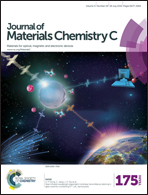Enhancement of electrorheological performance of electrorheological elastomers by improving TiO2 particles/silicon rubber interface
Abstract
As a composite, the particle/matrix interface may play an important role in the electrorheological (ER) performance of ER elastomers, which has been overlooked in previous studies. In this study, TiO2 particles and silicon rubber were used to prepare ER elastomers. To improve the interfacial bond strength, two coupling agents, 3-(trimethoxysilyl)propyl methacrylate (A174) and triethoxyvinylsilane (VTEO), were used to modify the surface of the TiO2 particles. Particle characterization results illustrate that the coupling agent modified TiO2 particles present little change in morphology but an increase in size with respect to the bare TiO2 particles. Compared with the bare TiO2 particle filled sample, the modified TiO2 particle filled elastomers present bridging structures between the particles and the matrix, enhanced mechanical properties, and a higher dielectric constant, indicating enhanced interfacial bond strength. The viscoelastic properties of the bare and the modified TiO2 particle filled elastomers were tested and compared. The results indicated that the ER performance, including the field-induced storage modulus and the storage modulus sensitivity, can be promoted by improving the bond strength between the TiO2 particles and the silicon rubber.


 Please wait while we load your content...
Please wait while we load your content...